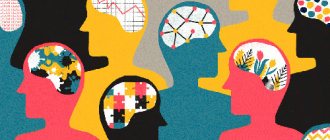What is mentality
The word “mentality” from Latin (“mens”) means mind, mental resource, consciousness, way of thinking. In the modern explanatory dictionary, this term is synonymous with the word “mentality” (from the Latin mentalite - mental). Both are deciphered as a combination of reason and feelings, reflected in a set of mental and spiritual attitudes of an individual or group.
Simply put, mentality is the prism through which we look at the world. It includes moral values, a set of mental and behavioral reactions, adaptive traits, upbringing, attitudes towards religion and culture.
It should be remembered that the mentality of an individual person is the experience of many generations of his family, people, country, therefore it is a mixture of the deep collective unconscious and individual consciousness.
In psychological terms, mentality is a reflection of the content of a person’s psyche: in what categories he thinks, how he interacts with the environment and what kind of life he leads. Habits, actions and attitudes are a reflection of mentality. The determining factor is the person’s environment - family and society.
Analysis of the concept “mental”
The meaning of this word in a broad sense should be considered as a complex concept that affects many aspects of a person’s spiritual life; the term itself is quite difficult to define. This is due to the fact that this term refers not only to historical and anthropological sciences, but is also inseparable from philosophy. What “mentally” means can be analyzed for a long time. Much depends on what sources of information you turn to, but no matter where you turn, there are common features that characterize this term.
The concepts of mentality actively developed in the spiritual sphere and for this reason are characterized by a refusal and departure from the centralization of historical development on European culture as a whole. Instead, the focus is on the stability of the individual's inner self, leading him to desire unification with historical and social communities. Based on this, the term “mental” can be understood in different ways. The meaning of a word can now be considered as a means of analysis and interpretation of humanities knowledge.
Mentality is considered by many sciences; it is given special importance in philosophy
Injury
30. Test for PTSD.
If you have a traumatic event behind you and you can’t stop thinking about it, you may have post-traumatic stress disorder (PTSD). The questionnaire will not give an exact answer as to whether it exists. But if you score high, you should definitely talk to a psychiatrist. Link.
31. Overcoming Trauma and PTSD.
A self-help guide for those who have experienced trauma. Inside are techniques from cognitive behavioral therapy that help you calm down when something reminds you of a traumatic event from the past, and get rid of cognitive distortions that aggravate the trauma. Link.
32. How to Heal From Trauma.
For those who love audio: an episode of the Verywell Mind project podcast about trauma. What are the reactions to traumatic events and what to do with your traumas, says psychotherapist, author of the book “Traumatized: Identify, Understand, and Cope with PTSD and Emotional Stress” Katie Morton. Link.
33. “The body remembers everything” Bessel all der Kolk.
Psychiatrist Bessel van der Kolk has been studying post-traumatic stress disorder since the 1970s and is considered one of the leading experts in the field. His book is a detailed guide to the consequences of trauma and ways to recover, surprisingly equally interesting and useful for both the psychiatrist and the general reader. Link.
34. The Wisdom of Trauma.
A comprehensive guide to understanding and healing trauma from psychotherapist Gabor Mate, no less experienced and respected than Bessel van der Kolk. You'll have to pay $200 for full access, but it's worth it: it's 7 hours of lectures by Gabor Mate himself and more than 20 conversations about trauma with other experts. Link.
35. “Victory is Healing” Paul Linden.
A bodywork trauma specialist recommends specific exercises to develop body-level awareness and cope with the effects of violence. Link.
36. How suffering helps us develop.
What if there is actually potential for growth hidden within psychological trauma? Exactly as Nietzsche wrote: what doesn’t kill makes you stronger. Now this is confirmed by research by psychologists: it happens that trauma becomes a catalyst for positive changes. For example, it makes a person stronger and more resistant to stress, helps to get closer to others and gives a feeling of completeness and meaning in life. Under what circumstances does such post-traumatic growth occur? Read in the Reminder text. Link.
37. “Shift-and-Persist” Strategies.
Psychologist Edith Chen has studied how people are affected by low socioeconomic status, an important factor in stress and the development of a variety of diseases, both physical and mental. Chen discovered that a special pattern of thinking helps to maintain optimism and even benefit from poverty and unsettled life. Details are in the study. Link.
Mentality of society
Mentality is not material, like thinking and imagination, so it cannot be quantified, it cannot be felt, tasted or heard. It cannot be directly observed, it is considered as an equal component of interaction, and does not have a direct influence on the formation of phenomena and processes.
Mentality is the content of the internal sphere of the subject, which is formed in the process of life, as a result of the transformation of the natural and social world into acts of subjectivity.
Mentality does not exist outside of its material carriers. Living in one place for a long time, people organize themselves into social groups, their mentality begins to change in the same way, because they are constantly influenced by the same factors. The existence of this fact confirms that the mentality is uniform, inherent in every social formation, but it can be radically different from the mentality of another society (for example, a group of people of a different religion).
The content of the mentality of society is greatly influenced by the traditions and values of a given environment of subjects. The mentality of society is the cultural environment in which we were raised, studied, received an education and currently live. It is a major factor influencing the thinking of every individual in the community, his/her daily behavior and decisions.
The mentality consists of two levels:
genetic: natural resources with which a subject is born - a level that cannot be changed.
acquired: our upbringing, our environment - a level that can be changed.
Mentality, as a subjective form, constitutes the spiritual world of the individual, reflecting the dynamics of the internal mental states and mental properties of the individual, which he manifests in specific reactions to the unique influences of culture and society. The mentality of the entire society, as a set of actions of subjects, forms a set of motivational norms of behavior in a given social group. In its subjective form, mentality transforms an individual into a personality, and a group into an integral society, united by values and culture. The etymological meaning of mentality is “soul,” or more precisely, “the composition of the soul.” However, modern usage of the term does not identify it specifically with the soul. The concept of the soul extends only to half of those phenomena and their properties that are included in the concept of the psyche. In the incarnation of the soul, it plays the role of the subject’s mental state, expressing the personal characteristics of behavior.
Mentality, as a way of seeing the world, is not identical to the concept of ideology. This is not a scientific, philosophical or ethnic system, but a psychological level of information reproduction, in which emotions are one with thoughts. Currently, the concept of mentality is used not only to designate cultural stereotypes and the unique thinking of large social groups, but also to interpret specific beliefs and ways of thinking of small groups. Psychical researchers believe that its formation begins at the age of 3 years and lasts about 12 years. At the same time, they highlight the most important factors influencing its formation:
- Parental behavior. At a very early age, the child unconsciously assimilates, to a certain extent, the worldview of his parents;
- Media, literature, cinema - all these elements leave their mark on the behavior, and therefore the mentality, throughout the subject’s entire adolescence;
- The influence of idols: real or imaginary figures, imitation of which influences the formation of mentality;
- State policy: foreign and domestic. This directs the vector of human development in the economic and cultural spheres, respectively, of each subject individually;
- Public organizations that influence the subject in one area or another
- Schools, churches, universities have a great influence.
Of course, this list can be continued, but it should be noted that the mentality of an ethnic group, which is formed over a long period of time, to its extent influences the formation of absolutely all these conditions, which then have a great influence on each subject.
Mentality forms a set of characteristics of a certain ethnic group or social stratum. And the key word here is not quantity, but quality, as a social and national structure formed historically and absorbing centuries-old traditions and culture.
Burnout
22. Maslach Burnout Inventory (MBI) test.
The most accurate self-diagnosis tool. Based on the theory of the same name, which is considered the gold standard in the study of burnout. Costs $15. Link.
23. MindTools burnout test.
An analogue of MBI is free, but its reliability and validity have not been confirmed by research. Which, however, is not so scary: the questions are simpler, but similar. Link.
24. “Burnout” by Emily Nagoski, Amelia Nagoski.
We burn out not because we have too much stress, but because we don't complete the stress cycle the way our ancient ancestors did. They did not have to spend the whole day fleeing from predatory animals: short periods of danger were always replaced by a time of relaxation and rest. The book describes eight techniques that will help your body understand that you have overcome the stressor and are now safe. By ending the cycle of stress, you make it a thing of the past. Link.
25. Reminder Burnout Guide.
The step-by-step plan for overcoming burnout is the most detailed one possible. Inside are signs for self-examination, methods of prevention and exercises to regain strength. Link.
26. Engy Health tracker.
The app syncs with the pulse oximeter on your smartwatch and tracks your stress and energy levels. Such constant monitoring is an excellent prevention of burnout: you can catch the condition at an early stage. And the technology behind the tracker is quite scientific: conclusions are drawn based on heart rate variability, which really strongly correlates with stress levels. Analogues are Welltory, Elite HRV and Firstbeat. Link.
27. Relaxation Diary.
Burnout is the result of chronic stress at work. This means that in order not to burn out, you need to effectively rest in the evenings on weekdays and on weekends - so that the cortisol level drops to normal. A relaxation diary from the Australian Center for Clinical Interventions will help you rest properly. Link.
28. Stress management course.
Deep Mind is a mindfulness consulting agency that helps companies implement safe and effective communication principles and train employees in mindfulness practices. They have a two-week course on stress management and burnout prevention, and also have their own Telegram channel. Link.
29. Practice to combat burnout.
Special meditation for burnout recorded by Deep Mind. Aimed at working through unpleasant emotions that we accumulate under stress. Link.
Illustrative examples of mentality
What is mentality using simple examples.
- In Russia, at the beginning of every spring, people celebrate Maslenitsa: they bake pancakes for a week, and then organize festivities during which they burn an idol, symbolizing farewell to winter. In India they do not know about this and, most likely, will treat such a tradition with understanding.
- Russian platforms are full of people bidding him farewell with hugs and kisses. In France, such behavior at train stations is strictly prohibited - you can even be fined. This is due to the fact that railway platforms used to be very narrow, and people hugging each other interfered with the movement of traffic.
- If you have a guest, you will probably offer him a cup of tea with something nice as a gesture of hospitality, or you can even set a rich table with something stronger. In China, they serve a cup of tea instead of saying, “Shouldn’t you go home?” This is the difference in mentality.
Bipolar disorder
- How common: Bipolar disorder is a registered mental disorder in 45 million people worldwide.
This disorder is characterized by polar changes in mood - periods of rise (mania or hypomania) alternate with periods of decline (depression). This is not like simple emotionality, when a person is either sad or happy - everything is aggravated to the maximum.
During an episode of mania, euphoria is felt. A person with Bipolar Disorder feels like they live in the best of all possible worlds, are incredibly talented, and are able to multitask. At the same time, he may not sleep for days and refuse to eat. Often during periods of mania, people engage in risky behavior without realizing the consequences, such as engaging in unsafe sex or impulsively spending a lot of money. Depending on the type of bipolar disorder, hypomania may occur instead of mania, in which the same symptoms appear, but they are not as pronounced.
Mania or hypomania is replaced by a period of depression - a time of melancholy and inner emptiness. If before this a person talked a lot and quickly about everything in the world, now he can refuse to communicate. It is difficult for him to concentrate on anything and make any decision. Many people feel completely powerless and unable to do even the simplest things - take a shower or brush their teeth.
Bipolar disorder can occur several times a year, but more frequent occurrences occur. Between episodes, many feel completely normal. With the help of psychotherapy and medications, the condition can be controlled so that it does not greatly affect the quality of life. But a person with bipolar disorder does not always realize that something is wrong with him, and often refuses treatment.
Types of mentality
If you settle a group of people on a desert island: they will settle, they will have their own rules and norms of interaction, values, views on certain events inside and outside their society.
Subsequent generations adopt their worldview: this is how a mental connection between people of different times is historically formed.
There are different types of mentality:
- in accordance with the type of structure of society - people of the Middle Ages had a different worldview than modern people;
- by race (Asians, Europeans);
- gender mentality (female, male) - women are more inclined to show emotions, males tend to keep their feelings to themselves;
- age (children, teenagers, adults, elderly) - childish infantilism and senile wisdom;
- religious beliefs (Buddhists and Catholics think differently);
- by level of intelligence: intelligentsia, peasants - if you look at them in a restaurant, you can see a significant difference in their behavior at the table.
It cannot be said that mentality is a fixed phenomenon. The historical change in mentality over time can be represented in the form of the game “Broken Phone”, when people pass a word or gesture to each other in a chain.
At the same time, everyone brings something different, and the last participant demonstrates something completely different from what was originally intended. Therefore, the worldview of modern people is radically different from the worldview of people who lived several centuries ago.
The mentality is always about culture, about historical values, moral principles
Anxiety
38. SPRAS anxiety test.
The questionnaire of the famous American psychiatrist David Sheehan has been used in psychotherapeutic practice for almost 40 years. The higher the score on the test, the greater the likelihood of a serious problem: a good incentive to consult a specialist. Link.
39. “Freedom from Anxiety” by Robert Leahy.
A book that psychotherapists themselves recommend to clients with anxiety disorders, depression and PTSD. Inside are the basic principles of combating anxiety and specific techniques from cognitive behavioral therapy. Link.
40. An application for accepting Worry Time alarms.
Avoiding anxiety only makes it worse. Accepting emotions, on the contrary, increases the ability to tolerate them. There is even an exercise for this - “Time to Worry”. Set aside 5-30 minutes a day and during this period do not suppress emotions as usual, but allow yourself to feel them as intensely as possible. The rest of the day is for calm. Here's an app to do the exercise. Unfortunately, it only works on Android. Link.
41. Mental practices: ABC, WOOP and others.
Reminder has collected different practices from cognitive behavioral therapy that can be done in writing and orally. Suitable for combating obsessive, restless thoughts, increasing motivation and achieving goals. Link.
42. Guide to cognitive distortions.
Clinical psychologist and creator of the mental health resource PsychCentral John Grohl describes the 15 most common cognitive distortions that lead to anxiety and depression. He also shares ways to rid your thinking of mistakes and make it more positive. Link (available from Russia via VPN).
43. Self-hypnosis application HypnoBox.
Developed by certified hypnotherapist Bernard Teves, who specializes in anxiety disorders and self-esteem issues. Inside are audio sessions for self-hypnosis in English, including those for relieving anxiety and tension. Link.
44. The Anti-Anxiety Notebook.
Paper diary based on cognitive behavioral therapy. It was created by psychologist, researcher at Columbia University and the US National Institutes of Health (NIH) Hod Tamir. Inside are exercises against stress and anxious thoughts, advice from psychotherapists and a hundred pages for freewriting. A diary will not replace psychotherapy. But it will help you feel lighter in moments of anxiety - and experience such moments less often. Link.
45. How to be anxious? Instructions.
What if anxiety doesn't need to be relieved? Maybe it is she who gives us the strength to act? True, we are not talking about the anxiety we are used to, but about existential anxiety - the one that Kierkegaard, Heidegger and Sartre write about. Often it is hidden behind a smaller, everyday one. And if we decide to face such anxiety, it will free us and make life more meaningful. Here's how to do it. Link.
46. BrainFM relaxation application.
Inside is music generated by artificial intelligence. It is supposed to somehow influence brain waves and help you relax - or, conversely, concentrate. Link.
47. Telegram bot Epicurus.
Promises to teach you to worry less in 14 days. Every day the bot sends theories from expert psychologists: about the functions of emotions, types of anxiety, types of anxious thinking, and so on. Then it helps to practice a new skill. For example, freeing automatic thoughts from cognitive distortions and calming the brain with mindfulness practices. Link.
Lisa Summer / Pexels
What is mental health
Mental health is a concept that describes an internal state that reflects a person's emotional and mental well-being and the absence of mental problems.
This is spiritual or mental health, indicating mental maturity. What is mental health:
- Integrity of mind and body;
- Healthy self-criticism (I know what is right and wrong, I respect the law and moral principles);
- identity consistency (I know who I am, what I am, why I am);
- lack of internal tension (fears, anxieties, prolonged psychological suffering);
- harmony with yourself and the world around you - satisfaction in relationships with people and in yourself;
- ability to plan, set goals and work to achieve them;
- good mood, optimism;
- control over one's own behavior, the ability to consciously change it
- calmness, self-confidence.
If a person’s mental level is “at the right level,” he is able to maximize his potential - realize his abilities and turn them into talents.
Such a person has a high degree of stress resistance, so he easily adapts to changes in the environment and effectively copes with difficulties. A person's work brings him pleasure and at the same time makes a quality contribution to society.
In conclusion
Let's summarize the topic:
- mental level is the level of a person’s thoughts. It is also a special dimension along with the astral plane;
- Esotericists believe that all diseases are created by our wrong thoughts. And changing thoughts can heal illnesses;
- mental connections are established between loved ones, lovers and relatives. They can persist for a very long time, often requiring work to break them completely (there are special practices for breaking mental connections).
Finally, I offer a thematic video:
Why is it important to maintain your mental health?
Mental health is essential for living a fulfilling life. You may be physically ill, but mentally healthy, enjoying life and feeling good.
But if a person is mentally ill, no amount of physical health will make him happy. Mental suffering is the most severe. And they are not easy to cure, magic pills will not help, only long-term work with yourself. This requires at least willpower.
If a person’s memory, attention, or thinking deteriorates, he is considered sick, even if he has no physical disabilities.
Symptoms that indicate that a person is mentally ill:
- Constant tension, stress. Inability to relax and let go of a situation
- Frequent mood swings. Emotional instability.
- Excessive aggressiveness. Reaction to other people's actions, and often unreasonable
- fatigue, constant fatigue, laziness. Lack of energy, often in a state of lemon exhaustion.
- Constant feeling of guilt. Feelings of unhappiness, anger, unwantedness and strangeness. Often blame yourself for your actions, scold yourself, perhaps even punish yourself.
- Panic attacks, fear of the dark, closed spaces, certain objects
- Detachment from people, isolation, closedness, loneliness
- Constant feeling of anxiety. Feeling depressed and stressed for long periods of time.
Perfectionism
12. Test for perfectionism.
Striving for an ideal that is never attainable makes life very difficult. But it’s one thing when you want to do something well, another when a simple “good” is always not enough. Check how infected you are with perfectionism. Link.
13. “The Gifts of Imperfection” by Brené Brown.
A University of Houston shame researcher talks about the power that comes from admitting imperfection and vulnerability. Brown herself is no stranger to perfectionism, so the book is very personal. Thanks to this, it will become a better cure for perfectionism than impersonal scientific data and abstract advice from psychologists. Link.
14. Self-esteem workbook
. One of the foundations of perfectionism is an inadequate self-image. The Australian Center for Clinical Interventions has collected everything you need to correct it. First, learn the theory about how self-esteem is formed. Then do exercises that will turn negative thoughts and beliefs into realistic ones. Link.
15. Research on perfectionism.
Why do perfectionism and depression go hand in hand? How does the inner world of a perfectionist work? Why is his suffering so difficult to alleviate with psychotherapy? These questions are answered in detail in a scientific article by Russian researcher of perfectionism and depression Alla Kholmogorova, with links to other important works on this topic. Link.
16. How to Cope With Anxiety.
Cambridge University researcher Olivia Remes deconstructs perfectionist anxiety in a TED talk and offers a radical and powerful way to deal with the typical perfectionist problem: procrastination. Link.
17. Podcast “This is Failure.”
A podcast about situations in which something went wrong. A variety of heroes talk about them: from the poetess Linor Goralik to the co-founder of the Yasno psychologist selection service, Danila Antonovsky. Listening to others joke about their failures is one of the best ways to come to terms with your imperfections. Link.
18. Test for character strengths VIA-IS.
This questionnaire is used by coaches and recruiters in companies. Why not use it yourself? The test will show you what you are already good at and what you can work on. Such a realistic assessment of oneself is not at all the same as perfectionism. Link.
19. Self-compassion test.
The opposite of perfectionism is self-compassion, a kind and compassionate attitude towards yourself. Check how typical it is for you. Link.
20. Practice self-compassion.
It came from Buddhism, and is now being studied by scientists. It turns out that practice reduces depression, anxiety and stress, increases happiness and makes us more confident. Here are the best exercises that University of Texas professor and self-compassion researcher Kristin Neff recommends. Link.
21. Selfcarist Space.
Russian project about self-compassion, mental hygiene and mindfulness. Useful materials are on Instagram and Youtube channel. There is also an online course for developing self-compassion and self-kindness. They teach specific techniques that will help you reduce self-criticism and become your own best friend. Link.
How to help yourself maintain your mental level
Practice self-reflection. This helps you look inside yourself and see your reactions to different situations. Self-analysis helps identify feelings and emotions. Why do you behave one way in one situation and another in another?
Surround yourself with good people. It is important that the environment is positive, that you feel comfortable being around them, that you can trust them. Toxic people must be cut out of your life, you must say goodbye to them, avoid them.
Get physically active. Sport helps you feel better, you have more time to do things, and you sleep less. Your mind is not clouded, and you have more and more energy for new achievements.
Give yourself more fresh air and oxygen to your brain. You will feel better within a few days.
Do new things. Try to explore the unknown, read more, think, learn. In general, feed your brain with useful information. Don't allow yourself to degrade, always move forward, reach new heights.
Accept people with their flaws, weaknesses and problems. If someone is dear to you, don't remember him, don't try to change him, accept him. The struggle takes a lot of energy, a lot of negative emotions will spill out. There will also be stress, anger, anxiety, guilt. Don't torment yourself with these feelings, free yourself from them. Tell yourself: “Yes, he is like that, but I’m not going to play his game and get angry at his overprotectiveness, I’ll just accept him for who he is, because he’s the one I care about.”
Train your confidence. Don't be afraid to speak, express your thoughts and feelings. You are an individual, which means you have the right to your own opinion. To remain silent means to throw your needs, feelings and desires into the corner. This leads to mental suffering and feelings of inferiority.
Ask for help. If you can’t cope, don’t take on this burden, don’t torment yourself with guilt, excessive responsibility, or fear that you won’t be able to cope. Just ask a loved one for help, trust him, share the burden. This is not a sign of weakness, it is self-love.
Analyze situations. Negative emotions make things worse, don't let them consume you. Analyze why you feel irritated, angry, and furious at one time or another. What or who is the problem? You need to find the reason. Is it lack of sleep, fatigue, or is it a matter of a specific person? Change your daily routine, schedule, or try to minimize your interactions with this person.
Plan, set goals and strive to achieve them. Chaos in your head leads to destruction in your life. Organize your thoughts. Create a plan and routine to make it easier to follow. Don’t accumulate a lot of unnecessary information in your head, it’s better to write it down. Don't overload your head with unnecessary worries.
If you cannot do this on your own, then a psychologist, psychotherapist, and sometimes a psychiatrist are the people who will help you sort out your thoughts. Don't be afraid to turn to professionals.
Stress
1. Test: The Perceived Stress Scale (PSS).
A health questionnaire will determine how high your stress levels are right now. Link.
2. Test: What Are Your Stress Triggers?
The Psychology Today project questionnaire will help you figure out what events cause a lot of stress for you personally. If you know your triggers, you can manage them and avoid unnecessary worries or be prepared for them. Link.
3. “Good Stress” by Kelly McGonagall.
Stress is inevitable. But exactly how it affects us depends on perception: if you believe that stress is harmful, it will indeed shorten your life. Optimizing stress starts with changing the way you think about it. How to change your thinking, says a Stanford professor who has been researching stress for many years. Link.
4. How Resilience Works.
Why do some people cope with stress better than others? It's all about a special ability to maintain objectivity, clarity of mind and calm in difficult situations and get out of them without much damage. Psychologists call this quality resilience - by analogy with physics, where this refers to the ability of solid bodies to restore shape after mechanical pressure. The good news is that resilience can be developed. Here are the tips. Link.
5. Noise canceling headphones.
Just two minutes in silence is enough to relax and normalize blood pressure. Even calm music does not give such an effect. So noise-cancelling headphones will come in handy. The ideal option is Bose Noise Canceling Headphones 700 or AirPods Max. But AirPods Pro will cope with the task. Link.
6. Practice shaking.
Animals know how to relieve stress: they simply tremble or shake themselves - and it goes away. We humans have forgotten how to do this: we have become too intelligent. Instead, we suppress emotions - and as a result, acute stress becomes chronic. Why not learn to shake again? Here are three great “trembling” practices. Link.
7. Insight Timer Applications.
If you meditate regularly, your resistance to stress increases. Here is the largest free collection of guided meditations: more than 100 thousand. Link.
8. Virry VR application.
What if you meditate not at home, but in the middle of the African savannah? This is possible - in virtual reality. And there you can feed a lioness with meat or bathe a rhinoceros. Small experiments have shown that it reduces stress, improves memory and alleviates pain. Link.
9. Practice free movement.
If still meditation is difficult, try practicing in motion - for a more complete experience of emotions. Link.
10. Progressive muscle relaxation.
The practice is based on the principle: strong tension is followed by strong relaxation - both physical and emotional. Therefore, all you need to do is alternately tense and relax your muscles. But for this to really calm you down, you need to act consistently and concentratedly. The best way to start is with our audio guide: follow the instructor's voice for 25 minutes and then evaluate your sensations. Link.
11. Muse meditation hoop.
Equipped with seven electroencephalographic sensors, a device for combating stress. Monitors brain activity during meditation and transmits information to your phone, tablet or computer. At the same time, he gives advice on how to quickly achieve a peaceful state. Link.
Mindfulness
85. Foundations of Mindfulness course.
A hands-on mindfulness course from Rice University. There is a theory about the fundamental concepts of mindfulness, and interactive exercises. Link.
86. Course Science of Meditation.
A course from Princeton University for those who want to understand how Buddhist philosophies fit into the scientific understanding of the brain and what meditation is from a neuroscience perspective. Link.
87. Waking Up app.
Guided meditations developed by scientist, philosopher, and bestselling author Sam Harris. Inside is a basic course of 50 ten-minute meditation lessons, as well as lectures and interviews. Tim Ferriss and Peter Attia recommend. Link.
88. MindFulness marathons.
A project by the head of the mindfulness department at the Association of Cognitive Behavioral Psychotherapy, Snezhana Zamalieva. It’s worth taking a closer look at marathons to develop awareness. These are video series with practices for managing attention, emotions and stress, breathing exercises and practices for developing self-compassion. Link.
89. How we think about the body. A brief overview of the four paradigms of corporeality.
The embodiment approach is similar to body-oriented therapy. But the idea at its core is much larger: stop pitting the mind against the body and think of them as a single whole. Therefore, you cannot train awareness of the mind and ignore the body. Alexandra Vilvovskaya, head of the international training program Embodied Facilitator Course Russia, talks about this approach and other ways to think about the body. Link.
90. Embodied Peacemaking: Body Awareness, Self-Regulation and Conflict Resolution.
A book by body therapist and embodiment instructor Paul Linden about developing awareness at the body level. Short (only 160 pages), but most useful: inside - contact exercises for relaxation and development of inner strength, love, spontaneity, sensitivity and other important qualities. Link.
Panic attacks
48. How to cope with a panic attack?
The good news is that panic attacks are well studied and are easier to treat than other types of anxiety. The bad news: there is little correct information in Russian on how to work with panic attacks. Relaxation techniques will not help in this case. Clinical psychologist Tatyana Pavlova tells how to act. Link.
49. Anti-Panic application.
Teaches how to deal with panic attacks using cognitive behavioral therapy methods. Inside is an “audio tablet” that you can listen to for emergency help during a panic attack, and a guide to breathing exercises that relieve tension. Link for iOS, for Android.
Meaning
100. “Existential psychotherapy” Irwin Yalom.
One of the founders of existential psychology writes about four existential givens: death, responsibility, isolation and lack of meaning. This is a textbook, but easy to read. Useful for everyone, because the deepest cause of any psychological problem, be it depression or just a feeling of unhappiness, is horror of existential givens and flight from them. Link.
101. How to find the meaning of life and why is it needed?
Reminder's definitive guide to finding meaning in life. First, we’ll tell you how mindfulness affects health – mental and physical. Then - what to do and how to think in order to gain such meaningfulness. Link.
102. “We are all mortal” by Atul Gawande.
The famous American surgeon reflects on old age and death. Mainly about how a conscious attitude towards death - your own and that of others - can fill life with meaning. Link.
103. Everything Happens Podcast.
Writer Kate Bowler learned at age thirty-five that she had stage 4 cancer. Previously, she believed that we are able to withstand all the tests that come our way, and these tests are not random: everything happens for a reason. She also believed in the power of positive thinking. However, the illness forced her to reconsider literally everything - and embark on a search for new meanings. That's what she does on the podcast, along with guests who also talk about difficult and sad moments in life - and how they changed them. Link.
104. Dalai Lama, Howard Cutler "The Art of Being Happy."
Howard Cutler is a psychotherapist. The Dalai Lama needs no introduction. In the book, Cutler asks questions about the meaning of life, suffering, compassion and obstacles, and the Dalai Lama answers. Link.
Thinking technique
Consists of three simple steps.
- We highlight key statements.
- We make them pay for themselves.
- We build a chain (model) from them.
The wording is simple, but contains a number of things that are not obvious. You need to figure out what key statements and how to highlight them in speech. And also how to make them pay off . This is what we will do. And to do this, you need to figure out what speech is in general?
Happiness
91. Happiness in diagrams.
Reminder collected 9 graphs from well-being studies. They explain why we feel happy—or unhappy. Link.
92. Test for the level of happiness PERMA.
A scientific test that will tell you how happy you are—and maybe tell you exactly where you're lacking. Based on the happiness model of the famous psychologist and positive thinking specialist Martin Seligman. The model is described in detail in the bestseller “How to Learn to Be Optimistic.” Link.
93. Course The Science of Wellbeing.
Psychology professor Laurie Santos developed this course for Yale students in 2021. It is incredibly popular: Santos talks about the theory of positive psychology and adds practice to this - specific techniques that will be useful to feel happier. Link.
94. “Happiness Hormones” by Loretta Breuning.
A professor emeritus at the University of California explains how our behavior is controlled by neurotransmitters and old neural connections—and teaches us how to use them to our advantage. Link.
95. Gratitude Gratitude Journal.
The practice of gratitude teaches you to notice the good and makes you happier. It is especially useful for pessimists and those who are accustomed to belittling themselves and their merits. In the first case, write in your diary what good things happened during the day, what you are grateful for that day, even if it seems like a small thing. And if you scold yourself all the time, write down 5 things that you did well enough for which you should say “thank you” to yourself. You can write in a regular diary or the Gratitude app. Link for iOS, Android.
96. “Happiness: Lessons from a New Science” by Richard Layard.
Does rich mean happy? Not so simple. English economist Richard Layard explains why incomes have increased over the past half century, but along with them there has been an increase in depression, alcoholism and crime. In exploring happiness, he turns to neuroscience, economics, sociology and philosophy. Link.
97. “The Happiness Trap” by Russ Harris.
What if the pursuit of happiness is what makes us unhappy? An Australian psychologist refutes the popular idea that the meaning of human life is to be happy. Suitable for those who are tired of obsessive “positivity” and are looking for more meaningful and deeper satisfaction than the idea of hedonism promises. Link.
98. “Happy Ever After” by Paul Dolan.
What is your ideal life? Do you have any idea that there is happiness in this ideal life? English professor and happiness researcher Paul Dolan exposes social patterns and myths and explains why there is no happiness when life looks perfect. Link.
99. How to learn to induce a flow state?
It happens that we are so captivated by a series or game that we do not notice how time has passed. A hobby or conversation with an interesting person can also be very captivating. This state is called flow. It’s much less common to immerse yourself in it while working or studying. But being in the flow is a skill. It can and should be developed: it makes a person not only more productive, but also happier. Here are the exercises for training. Link.









